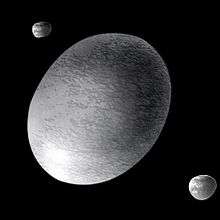(24835) 1995 SM55
| Discovery | |
|---|---|
| Discovered by | Nichole Danzl[1] |
| Discovery date | 19 September 1995 |
| Designations | |
| MPC designation | (24835) 1995 SM55 |
|
Cubewano (MPC)[2] Extended (DES)[3] | |
| Orbital characteristics[4] | |
| Epoch 13 January 2016 (JD 2457400.5) | |
| Uncertainty parameter 3 | |
| Observation arc | 11751 days (32.17 yr) |
| Aphelion | 46.152 AU (6.9042 Tm) |
| Perihelion | 37.372 AU (5.5908 Tm) |
| 41.762 AU (6.2475 Tm) | |
| Eccentricity | 0.10512 |
| 269.88 yr (98574.7 d) | |
Average orbital speed | 4.60 km/s |
| 327.655° | |
| 0° 0m 13.148s / day | |
| Inclination | 27.092° |
| 21.103° | |
| 72.369° | |
| Earth MOID | 36.4871 AU (5.45839 Tm) |
| Jupiter MOID | 32.8196 AU (4.90974 Tm) |
| Jupiter Tisserand parameter | 5.141 |
| Physical characteristics | |
| Dimensions |
174 km[5][6] <704km[7] |
| 8.08 h (0.337 d) | |
Sidereal rotation period | 8.08 h[4] |
| 0.7 (assumed) | |
| Temperature | ~43 K |
|
(Neutral) B−V=0.65, V−R=0.39[8] B0−V0=0.628[9] | |
| 4.8[4] | |
|
| |
(24835) 1995 SM55, also written (24835) 1995 SM55, is a trans-Neptunian object (TNO) that resides in the Kuiper belt that was discovered on September 19, 1995, by Nichole M. Danzl. Until (19308) 1996 TO66 was discovered, it was the second-largest known object in the Kuiper belt, after Pluto.
Origin
Main article: Haumea family
Based on their common pattern of IR water-ice absorptions, neutral visible spectrum[10] and the clustering of their orbital elements, the other KBOs (19308) 1996 TO66, (55636) 2002 TX300, (120178) 2003 OP32 and (145453) 2005 RR43 all appear to be collisional fragments broken off of the dwarf planet Haumea.
References
- ↑ List Of Transneptunian Objects Archived 2007-06-21 at WebCite
- ↑ "MPEC 2009-R09 :Distant Minor Planets (2009 SEPT. 16.0 TT)". IAU Minor Planet Center. 2009-09-04. Retrieved 2009-10-04.
- ↑ Marc W. Buie. "Orbit Fit and Astrometric record for 24835" (2004-11-02 using 119 of 123 observations). SwRI (Space Science Department). Retrieved 2009-10-04.
- 1 2 3 "JPL Small-Body Database Browser: 24835 (1995 SM55)" (2004-11-02 last obs). Retrieved 11 April 2016.
- ↑ Assuming a Haumea-like albedo of 0.7
- ↑ Dan Bruton. "Conversion of Absolute Magnitude to Diameter for Minor Planets". Department of Physics & Astronomy (Stephen F. Austin State University). Archived from the original on 23 March 2010. Retrieved 2009-12-27.
- ↑ John Stansberry; Will Grundy; Mike Brown; Dale Cruikshank; John Spencer; David Trilling; et al. (2007). "Physical Properties of Kuiper Belt and Centaur Objects: Constraints from Spitzer Space Telescope". arXiv:astro-ph/0702538
 [astro-ph].
[astro-ph]. - ↑ Snodgrass, Carry; Dumas, Hainaut (16 December 2009). "Characterisation of candidate members of (136108) Haumea's family". Astronomy and Astrophysics. 511: A72. arXiv:0912.3171
 . Bibcode:2010A&A...511A..72S. doi:10.1051/0004-6361/200913031.
. Bibcode:2010A&A...511A..72S. doi:10.1051/0004-6361/200913031. - ↑ David L. Rabinowitz; Bradley E. Schaefer; Martha W. Schaefer; Suzanne W. Tourtellotte (2008). "The Youthful Appearance of the 2003 EL61 Collisional Family". The Astronomical Journal. 136: 1502–1509. arXiv:0804.2864
 . Bibcode:2008AJ....136.1502R. doi:10.1088/0004-6256/136/4/1502.
. Bibcode:2008AJ....136.1502R. doi:10.1088/0004-6256/136/4/1502. - ↑ Pinilla-Alonso, N.; Licandro, J.; Gil-Hutton, R.; Brunetto, R. (June 2007). "The water ice rich surface of (145453) 2005 RR43: a case for a carbon-depleted population of TNOs?". Astronomy and Astrophysics. 468 (1): L25. arXiv:astro-ph/0703098
 . Bibcode:2007A&A...468L..25P. doi:10.1051/0004-6361:20077294.
. Bibcode:2007A&A...468L..25P. doi:10.1051/0004-6361:20077294.
External links
- Orbital simulation from JPL (Java) / Horizons Ephemeris
- (24835) 1995 SM55 at the JPL Small-Body Database
This article is issued from Wikipedia - version of the 11/19/2016. The text is available under the Creative Commons Attribution/Share Alike but additional terms may apply for the media files.
